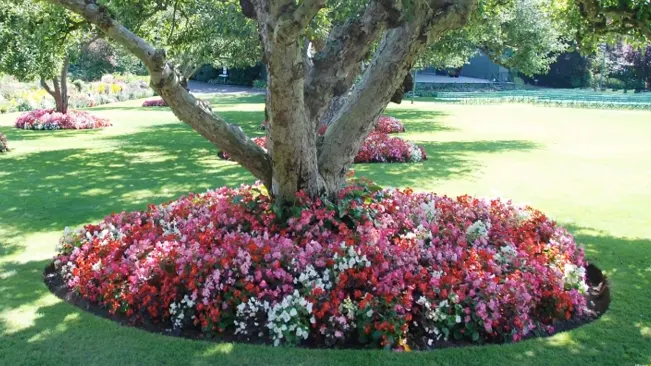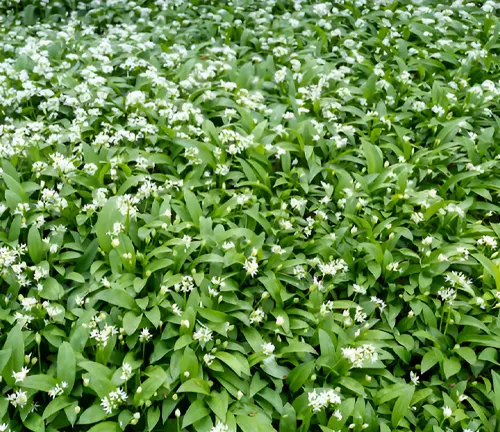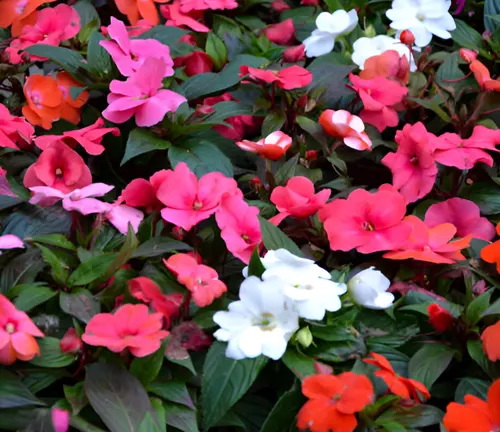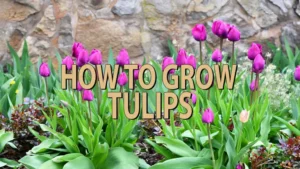How to Successfully Grow Flowers Around Your Tree
- October 1, 2024
- 0 comment
Growing flowers around a tree can transform a bare patch into a stunning landscape feature, providing color and variety. However, it also requires proper planning to ensure both the flowers and the tree thrive together.

Growing flowers around is about ensuring both plants have what they need to thrive. Trees and flowers often compete for resources such as light, water, and nutrients, so the key is to choose plants and planting methods that allow them to coexist. Understanding how to create a balance between the tree’s root system and the needs of the flowers is essential for a successful planting.
What Impacts Flower Growth Around Trees?
Before planting, it’s essential to understand the main factors that can impact your success.
- Tree Roots
Tree roots are notorious for out-competing other plants for water and nutrients. Most tree roots are found in the top 18-24 inches of soil, exactly where you’d want to plant your flowers. This can create a hostile environment for flowering plants. - Shade
Trees cast considerable shade, especially mature ones. The degree of shade varies depending on the type of tree, but most flowers require a good deal of sunlight to thrive. You’ll need to choose flowers that are tolerant of low light conditions to make the most of this area. - Soil Quality
The soil under trees is often compacted due to foot traffic or the tree’s root system. This reduces drainage and makes it harder for plants to establish themselves. The soil may also lack nutrients because the tree absorbs them all. - Watering
Trees often have extensive root systems that soak up most of the water before it reaches the flowers. As a result, plants around trees may suffer from drought stress unless they are watered correctly and frequently.
Types of Flowers Suitable for Tree Surroundings
Selecting the right flowers is crucial to creating a successful garden under a tree. Look for species that can handle lower light levels, tolerate root competition, and thrive in the moisture conditions typical beneath trees.

Perennials
Perennials like Hostas, Astilbes, and Heucheras are excellent for tree-shaded areas. They come back year after year, reducing the need to replant, and many varieties thrive in low-light environments.
Ground Covers
Ground covers such as Lily of the Valley and Sweet Woodruff are ideal for adding greenery and delicate blooms without needing deep roots or direct sunlight. They also help reduce soil erosion around the tree’s base.


Bulbs
Early-blooming bulbs like Crocuses, Snowdrops, and Daffodils work well under deciduous trees because they complete most of their growth before the tree fully leafs out in spring.
Annuals
Annuals like Impatiens and Begonias add seasonal color and can be replaced each year to keep the garden fresh. These flowers generally perform well in low light, but you’ll need to water them frequently since annuals are less drought-tolerant than perennials.

Practical Tips for Planting Flowers Around Trees
To maximize your success, follow these practical guidelines:
- Prepare the Soil
Before planting, loosen the soil around the tree carefully to avoid damaging the roots. Adding organic matter like compost can improve soil texture and provide much-needed nutrients for your flowers. Avoid building up too much soil or mulch around the tree trunk, as this can lead to rot or pest problems. - Use Mulch Wisely
Mulching around the flowers can help retain moisture and reduce competition from weeds. Organic mulch, such as bark or wood chips, breaks down over time, enriching the soil. However, make sure not to pile it up directly against the tree trunk leave a few inches of space to prevent moisture buildup around the bark. - Choose a Planting Technique
You can plant flowers around the tree either in small pockets or raised beds. Pocket planting involves digging individual holes for each plant, which minimizes root disruption. Raised beds may be necessary if the soil is extremely compacted or depleted of nutrients, but be careful not to bury the tree’s roots too deeply. - Water Smartly
Trees absorb most of the water, so you’ll need to water more frequently when flowers are newly planted. Use a soaker hose or drip irrigation to ensure that water reaches deep into the soil, benefiting both the flowers and the tree. Early morning watering reduces evaporation and ensures that moisture penetrates the ground before the heat of the day. - Fertilize Carefully
Light feeding is crucial to encourage flower growth without overwhelming the tree. Slow-release fertilizers can provide a steady supply of nutrients to the flowers over time. Avoid over-fertilizing, as trees usually need fewer nutrients than fast-growing flowering plants, and excess fertilizer can damage roots or promote disease.
Maintenance and Long-Term Care
Once your flowers around are established, regular maintenance is key. Remove dead leaves and spent blooms to keep your garden tidy and encourage new growth. Prune tree branches if necessary to allow more light to reach your flowers. Continue to water consistently, particularly during dry spells, and replenish mulch as needed to maintain soil moisture and prevent weeds.
Conclusion
Growing flowers around your tree doesn’t have to be a struggle. By understanding the challenges posed by tree roots, shade, and competition for resources, and by selecting the right plants for the conditions, you can create a beautiful, low-maintenance garden. Use mulch to protect moisture, water your plants properly, and maintain the soil quality to keep your tree and flowers healthy.
By following these steps, you’ll transform the bare, shaded area around your tree into a vibrant garden that enhances your landscape without harming the tree’s health. Remember, with the right approach, it’s entirely possible to achieve a balance where both your tree and flowers thrive. Happy planting!
Frequently Asked Questions (FAQ)
- What are the best types of flowers to plant around a tree?
The best flowers are typically shade-loving, shallow-rooted plants such as hostas, astilbes, heuchera, and groundcovers like vinca minor and ajuga. Drought-tolerant flowers like sedum and daylilies are also great options, especially for trees that absorb a lot of water. - How deep should I plant flowers around a tree?
Plant flowers shallowly to avoid disturbing tree roots. Use hand tools and plant at a depth suitable for the flower species, usually around 2-4 inches deep, depending on the plant’s needs. - How can I protect tree roots while planting flowers?
To protect tree roots, avoid deep digging around the tree’s base. Plant shallow-rooted flowers and use a layer of mulch to shield the roots and retain moisture without compacting the soil. - Will planting flowers around a tree harm the tree?
If done properly, planting flowers around a tree will not harm it. Ensure that you don’t damage the roots while digging, and avoid building soil up against the tree trunk, as this can lead to trunk rot. - Do flowers planted around a tree need more water?
Yes, flowers around trees often require extra watering since the tree roots absorb a large portion of the water in the soil. Deep watering can help both the tree and the flowers thrive, especially during dry periods. - What kind of mulch should I use around my tree and flowers?
Organic mulch such as wood chips, bark, or shredded leaves is ideal for mulching around a tree and its surrounding flowers. Mulch helps retain moisture, regulate soil temperature, and prevent weeds, but keep it away from direct contact with the tree trunk. - How can I improve soil quality for flowers around a tree?
Improve soil quality by adding organic compost or fertilizer around the base of the tree to enrich the nutrient-poor soil. Choose fertilizers that are beneficial for both the tree and the flowers, and avoid compacting the soil too much around the tree roots.

Kristine Moore
Forestry AuthorI'm Kristine Moore, a seasoned garden landscaping professional with over 30 years of experience. My extensive career has been dedicated to transforming outdoor spaces into stunning, sustainable landscapes. With a deep understanding of horticulture, design principles, and environmental stewardship, I have become a respected figure in the field, known for creating harmonious, visually appealing, and eco-friendly gardens. My commitment to excellence and continuous learning in landscaping trends and techniques has solidified my reputation as an expert in garden design and implementation.













Leave your comment